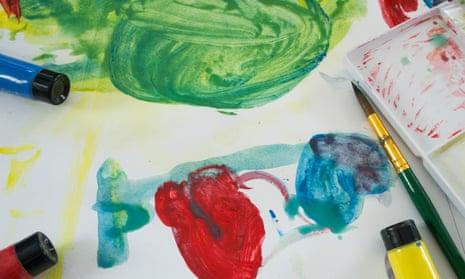From a young age, we learn to use words as our primary form of communication. For many people words are not enough to express the way they feel, while some cannot use them at all. This is where creative arts therapy comes in – the practise of using visual art, music, drama, dance and movement to communicate thoughts, feelings, trauma and experiences where words fail. Three creative arts therapists discuss their practices and how to pursue a career in the field.

Gwendolyn Rowlands, art psychotherapist
The strength of art therapy is its use of non-verbal communication. Working with paint and clay allows people a way, literally, to touch on very difficult experiences that can’t be talked about.
I work as an art psychotherapist across two primary schools in London, for the charity Place2Be. I work one-on-one with children, typically over the course of a school year.
There’s a variety of toys and materials in the art therapy room for them to play with, and the session is child-led. I carefully store their art work; it can be very powerful for them to look back at what they have created. It is possible to review the work with them and assess whether the therapy is meeting their needs. It’s very important they feel safe when I’m with them, so consistency and boundaries are an important part of the work.
I’m a sculptor and spent 15 years working as an artist and art teacher before I decided train as an art psychotherapist. I completed a masters in the subject at the University of Roehampton in 2014. Most art therapists have a primary degree in art, though they can come from different backgrounds, like healthcare.
It’s very important that art therapists keep up their own art work – because our practice is psychodynamic, meaning we use all of ourselves, the job can be very challenging and emotionally involving. So I start every day with 45 minutes of drawing. It’s a way of checking in with myself; I know how I’m feeling that morning by what is coming out on the page.
A big part of the training is undertaking personal therapy, which can be quite demanding. Starting therapy before doing the course gives you a flavour of what it might be like. Doing a foundation course, also helps.
It’s a competitive career but if you want the work you will get it. Like all areas of the arts you have to be resourceful. Budgets are stretched at the moment, but I am heartened by the fact that in the schools there’s a real awareness for the need of the work we do.

Grace Watts, music therapist and development director at the British Association for Music Therapy
All human beings are intrinsically musical and have the capacity to respond to music. Music plays a fundamental role in our identity, culture, heritage and spirituality. Regardless of an illness or disability, music can affect us deeply.
Music therapists draw upon the innate qualities of music to support people across the life spectrum, from mums-to-be to people at the end of life. Music therapy, for example, might help a child with autism communicate with others. For a person with dementia, music can be a way for them to feel valued and heard.
I work as a music therapist within a child development service in the NHS, working alongside paediatricians and nurses and other allied health professionals, including speech and language therapists, physiotherapists, occupational therapists, psychologists and social workers.
Music can be a social or a private experience, so music therapists work with individuals or groups. A session usually starts with a greeting, musical improvisation, song selection and a goodbye. My practice is informed by a number of approaches; I look at child development, but also emotional and psychological wellbeing. I work with children and their families, so parents might join in a session.
Having a high level of musicianship and being familiar with a wide range of musical genres is vital because our work tends to be improvised. I’m a bassoonist and have a degree from the Guildhall School of Music and Drama. I was involved in a musical educational campaign called Sing Up before training as a music therapist at the University of Roehampton.
Empathy, the ability to listen, and life experience are all crucial qualities to have; you may come into contact with really vulnerable people or people who have experienced trauma, so you need to be emotionally resilient and robust.
It’s an exciting career and growing field, with about 1,000 practising music therapists in the UK. The care sector is there for you to explore. Music therapists are entrepreneurial and your own interests and passions can determine where you find yourself working – that could be within education, hospitals, prisons, social care, research.

Caroline Frizell, programme convenor of dance movement psychotherapy at the University of Goldsmiths
Dance movement therapy is based on the principle that the body is something we all have and it carries our whole history – in our blood, bones and flesh. We connect with the outside world with the body and senses, so the body is a vessel for communication and understanding.
I run the dance movement psychotherapy MA at Goldsmiths University and a private practice from a converted barn next to my house in South Devon.
I’m a professionally trained dancer and started doing ballet when I was two. I went into community dance work and got involved with dancing with people with learning difficulties, before I decided to train as a dance therapist. After that I worked in special schools for 15 years.
The best bit of the job is the diversity of people I meet; it’s moving listening to their unique stories.
I see many clients who have done a lot of verbal therapy and feel there is something they can’t quite get out with words. Other people feel their creativity or spontaneous expression has been stinted in some way and they want to use the freedom of dance and movement to expand a part of themselves. Some people come raring to go and some come desperate to move but they are just not able to. I will usually guide a client back from the moment into a thinking space; dance therapy isn’t just a cathartic exercise to dance away your distress.
My practice is psychodynamic, and I’m really interested in how we work with the unconscious. Private practice can be a lonely job, so self care is important and I make sure I have regular meetings with peers.
Dance movement therapy is the youngest of the creative arts therapies and is growing. But with the curtailment of services, the first thing to go is usually therapy, so there are fewer full time jobs.
Training as a dance therapist is rewarding and an enormous investment – you have to undertake therapy, it costs a lot of money and you are pushed intellectually. My advice is to invest in some short courses, read a lot, speak to dance therapists and see if it’s really what you want to do before hand – and get some life experience first.
Looking for a job? Browse Guardian Jobs or sign up to Guardian Careers for the latest job vacancies and career advice

Comments (…)
Sign in or create your Guardian account to join the discussion